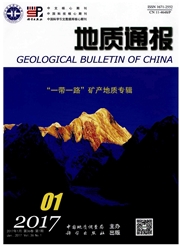

 中文摘要:
中文摘要:
天泉群岛出露于龙木错-双湖-澜沧江板块缝合带的中西段,也是目前该缝合带上所发现的第一套洋岛型岩石组合。通过野外踏勘、剖面测制等对天泉群岛进行了较为详细的研究,结果显示,天泉群岛由9个孤立、岩石组合不同的洋岛组成,其中独泉沟洋岛、屏风岭洋岛的洋岛组分齐全,见玄武岩、灰岩、砾岩、硅质岩等,其他洋岛的洋岛组分不全。天泉群岛与展金组复理石沉积为整合接触,表明其形成时代为晚石炭世-早二叠世。天泉群岛的厘定,说明龙木错-双湖-澜沧江大洋在晚石炭世-早二叠世仍具有成熟的洋壳。该项研究进一步丰富了龙木错-双湖-澜沧江板块缝合带的演化内容,为反演区域地质演化历史提供了依据。
 英文摘要:
英文摘要:
Located in the middle and western segments of the Lungmu Co-Shuanghu-Lancang River suture zone, Tianquan archipelago is the only set of oceanic islands in this suture zone. Based on field reconnaissance and profile measurement, the authors have reached the conclusion that Tianquan archipelago is composed of nine isolated oceanic islands, whose rocky combinations are different from each other. The rocky combination of Duquangou oceanic island and that of Pingfengling oceanic island of Tianquan archipelago are complete, comprising basalts, limestone, conglomerate and cherts, whereas the rocky combinations of the other oceanic islands are incomplete. Tianquan archipelago is in conformity with the flysch of Zhanjin Formation, indicating that it was formed in Late Carboniferous-Early Permian. The discovery of Tianquan archipelago demonstrates that the Lungmu Co-Shuanghu-Lancang River Ocean had a mature ocean basin in Late Carboniferous-Early Permian. The results achieved by the authors have enriched the study of the evolution of the Lungmu Co-Shuanghu-Lancang River suture zone and provided the basis for reconstructing the regional geological evolution.
 同期刊论文项目
同期刊论文项目
 同项目期刊论文
同项目期刊论文
 期刊信息
期刊信息
